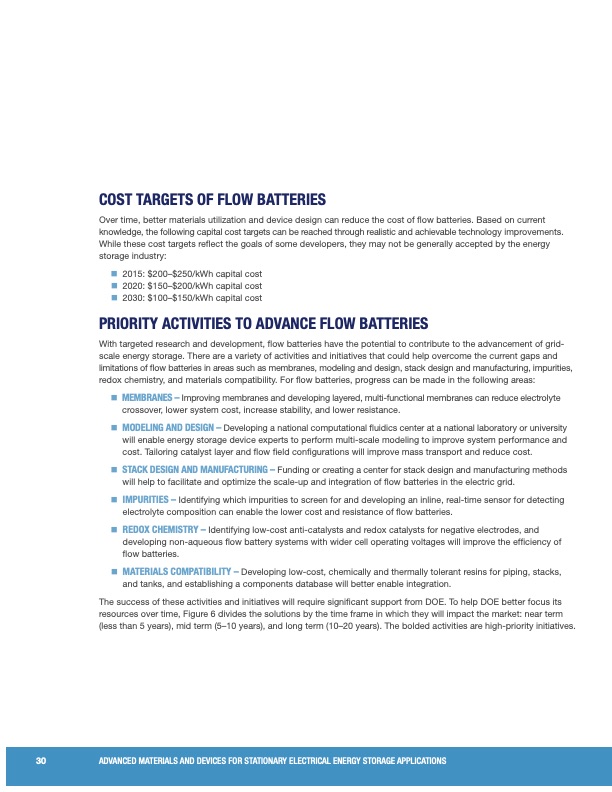
PDF Publication Title:
Text from PDF Page: 034
COST TARGETS OF FLOW BATTERIES Over time, better materials utilization and device design can reduce the cost of flow batteries. Based on current knowledge, the following capital cost targets can be reached through realistic and achievable technology improvements. While these cost targets reflect the goals of some developers, they may not be generally accepted by the energy storage industry: n 2015: $200–$250/kWh capital cost n 2020: $150–$200/kWh capital cost n 2030: $100–$150/kWh capital cost PRIORITY ACTIVITIES TO ADVANCE FLOW BATTERIES With targeted research and development, flow batteries have the potential to contribute to the advancement of grid- scale energy storage. There are a variety of activities and initiatives that could help overcome the current gaps and limitations of flow batteries in areas such as membranes, modeling and design, stack design and manufacturing, impurities, redox chemistry, and materials compatibility. For flow batteries, progress can be made in the following areas: n MEMBRANES – Improving membranes and developing layered, multi-functional membranes can reduce electrolyte crossover, lower system cost, increase stability, and lower resistance. n MODELING AND DESIGN – Developing a national computational fluidics center at a national laboratory or university will enable energy storage device experts to perform multi-scale modeling to improve system performance and cost. Tailoring catalyst layer and flow field configurations will improve mass transport and reduce cost. n STACK DESIGN AND MANUFACTURING – Funding or creating a center for stack design and manufacturing methods will help to facilitate and optimize the scale-up and integration of flow batteries in the electric grid. n IMPURITIES – Identifying which impurities to screen for and developing an inline, real-time sensor for detecting electrolyte composition can enable the lower cost and resistance of flow batteries. n REDOX CHEMISTRY – Identifying low-cost anti-catalysts and redox catalysts for negative electrodes, and developing non-aqueous flow battery systems with wider cell operating voltages will improve the efficiency of flow batteries. n MATERIALS COMPATIBILITY – Developing low-cost, chemically and thermally tolerant resins for piping, stacks, and tanks, and establishing a components database will better enable integration. The success of these activities and initiatives will require significant support from DOE. To help DOE better focus its resources over time, Figure 6 divides the solutions by the time frame in which they will impact the market: near term (less than 5 years), mid term (5–10 years), and long term (10–20 years). The bolded activities are high-priority initiatives. 30 ADVANCED MATERIALS AND DEVICES FOR STATIONARY ELECTRICAL ENERGY STORAGE APPLICATIONSPDF Image | Devices for Stationary Electrical Energy Storage Applications

PDF Search Title:
Devices for Stationary Electrical Energy Storage ApplicationsOriginal File Name Searched:
AdvancedMaterials_12-30-10_FINAL_lowres.pdfDIY PDF Search: Google It | Yahoo | Bing
Turbine and System Plans CAD CAM: Special for this month, any plans are $10,000 for complete Cad/Cam blueprints. License is for one build. Try before you buy a production license. More Info
Waste Heat Power Technology: Organic Rankine Cycle uses waste heat to make electricity, shaft horsepower and cooling. More Info
All Turbine and System Products: Infinity Turbine ORD systems, turbine generator sets, build plans and more to use your waste heat from 30C to 100C. More Info
CO2 Phase Change Demonstrator: CO2 goes supercritical at 30 C. This is a experimental platform which you can use to demonstrate phase change with low heat. Includes integration area for small CO2 turbine, static generator, and more. This can also be used for a GTL Gas to Liquids experimental platform. More Info
Introducing the Infinity Turbine Products Infinity Turbine develops and builds systems for making power from waste heat. It also is working on innovative strategies for storing, making, and deploying energy. More Info
Need Strategy? Use our Consulting and analyst services Infinity Turbine LLC is pleased to announce its consulting and analyst services. We have worked in the renewable energy industry as a researcher, developing sales and markets, along with may inventions and innovations. More Info
Made in USA with Global Energy Millennial Web Engine These pages were made with the Global Energy Web PDF Engine using Filemaker (Claris) software.
Sand Battery Sand and Paraffin for TES Thermo Energy Storage More Info
| CONTACT TEL: 608-238-6001 Email: greg@infinityturbine.com | RSS | AMP |